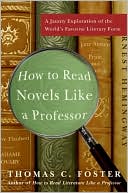List Books » How to Read Novels Like a Professor: A Jaunty Exploration of the World's Favorite Literary Form
Category Books
- Fiction Books & Literature
- Graphic Novels
- Horror
- Mystery & Crime
- Poetry
- Romance Books
- Science Fiction & Fantasy
- Thrillers
- Westerns
- Ages 0-2
- Ages 3-5
- Ages 6-8
- Ages 9-12
- Teens
- Children's Books
- African Americans
- Antiques & Collectibles
- Art, Architecture & Photography
- Bibles & Bible Studies
- Biography
- Business Books
- Christianity
- Computer Books & Technology Books
- Cookbooks, Food & Wine
- Crafts & Hobbies Books
- Education & Teaching
- Engineering
- Entertainment
- Foreign Languages
- Game Books
- Gay & Lesbian
- Health Books, Diet & Fitness Books
- History
- Home & Garden
- Humor Books
- Judaism & Judaica
- Law
- Medical Books
- New Age & Spirituality
- Nonfiction
- Parenting & Family
- Pets
- Philosophy
- Political Books & Current Events Books
- Psychology & Psychotherapy
- Reference
- Religion Books
- Science & Nature
- Self Improvement
- Sex & Relationships
- Social Sciences
- Sports & Adventure
- Study Guides & Test Prep
- Travel
- True Crime
- Weddings
- Women's Studies
How to Read Novels Like a Professor: A Jaunty Exploration of the World's Favorite Literary Form »

Authors: Thomas C. Foster
ISBN-13: 9780061340406, ISBN-10: 0061340405
Format: Paperback
Publisher: HarperCollins Publishers
Date Published: July 2008
Edition: (Non-applicable)
Author Biography: Thomas C. Foster
Tom Foster is Professor of English at the University of Michigan, Flint, where he teaches classes in contemporary fiction, drama and poetry as well as creative writing and composition. He has written several books on twentieth-century British and Irish literature and poetry and lives in East Lansing, Michigan.
Book Synopsis
Of all the literary forms, the novel is arguably the most discussed . . . and fretted over. From Miguel de Cervantes's Don Quixote to the works of Jane Austen, F. Scott Fitzgerald, Ernest Hemingway, and today's masters, the novel has grown with and adapted to changing societies and technologies, mixing tradition and innovation in every age throughout history.
Thomas C. Foster—the sage and scholar who ingeniously led readers through the fascinating symbolic codes of great literature in his first book, How to Read Literature Like a Professor—now examines the grammar of the popular novel. Exploring how authors' choices about structure—point of view, narrative voice, first page, chapter construction, character emblems, and narrative (dis)continuity—create meaning and a special literary language, How to Read Novels Like a Professor shares the keys to this language with readers who want to get more insight, more understanding, and more pleasure from their reading.
Publishers Weekly
Covering a range of novelists from the classic to the slightly idiosyncratic, Foster (How to Read Literature Like a Professor) expounds on the various elements of novel construction and offers advice on how to analyze them. Foster maintains a conversational tone throughout, offering pithy interjections among his literary explication (on the possibility of having a reliable narrator in Huck Finn: "Now seriously, where's the fun in that?"). Each chapter of the book breaks down a different part of the novel, from the significance of Faulkner's repeated use of the word "self-abnegation" to the intermingling of philosophy and fiction, particularly in the work of John Fowles, one of Foster's favorite writers. Foster's enthusiasm for his subject is palpable, but his audience will probably be limited to students, given the combination of examples like Joyce, Faulkner and Woolf (English course staples) and the tone of Foster's explanations-often simplistic to a degree that would seem condescending to more experienced readers, as when he emphasizes that "the narrative voice in a novel is a device invented by the writer" and then explains the idea for a full paragraph. (July)
Copyright © Reed Business Information, a division of Reed Elsevier Inc. All rights reserved.Table of Contents
Subjects
 Literary Criticism
Literary Criticism  Genres & Literary Forms
Genres & Literary FormsFiction Books & Literature
 Literary Criticism
Literary Criticism  Literary Reference
Literary Reference
